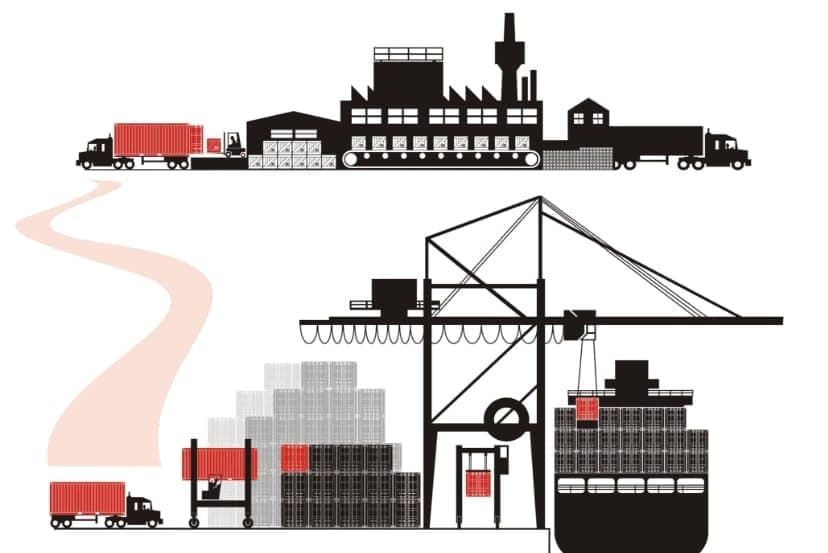Ever wondered how goods from one corner of the world find their way to another? Well, here’s a mind-boggling fact: a whopping 80% of stuff we buy takes a ride on the high seas. Now, picture this vast ocean of trade. What keeps everything sailing smoothly? Two not-so-famous heroes – Shipping Bills and Bills of Lading.
In this journey, we’re not diving into a sea of jargon. No, we’re grabbing a lifebuoy and paddling through the basics. These documents are like passports for goods, making sure they reach their destinations hassle-free. So, buckle up! We’re setting sail to uncover the secrets of Shipping Bills and Bills of Lading, and you’re invited to join the voyage. Smooth waters ahead!
Shipping Bills: Your Global Trade Permission Slip
In the world of selling stuff worldwide, a Shipping Bill is like the golden ticket. It’s your official permission slip from the customs folks, saying, “Yep, you’re good to send your goods out into the world!”
This magical document spills the beans on everything – who’s sending the goods, who’s getting them, what’s inside, and where they’re going. It’s like the first chapter in the book of your goods’ adventure.
When it comes to crossing borders, the Shipping Bill is the VIP pass. It’s not just a formality; it’s the key to unlocking the doors to international trade. So, think of it as your goods’ passport – stamped and ready to explore the global market.
Decoding Bills of Lading: Your Goods’ Travel Ticket
In the intricate web of global trade, a Bill of Lading emerges as the golden ticket that accompanies your goods on their journey across the seas. Think of it as a travel document – not for you, but for your precious cargo.
At its core, a Bill of Lading is a receipt and a contract rolled into one. It’s the paperwork that acknowledges your goods have hopped on board a ship, and it outlines the terms of their voyage. From the who’s who in the shipping game to the nitty-gritty details of your cargo, the Bill of Lading spills the beans.
In the dance of international trade, this document takes center stage. It’s not just proof that your goods are on the move; it’s also the key that can unlock the treasure chest of your shipment when it reaches its destination. So, when your goods sail into the vast ocean of global commerce, the Bill of Lading is their trusted travel companion, ensuring a safe and regulated journey.
Also Read : Bill of Lading: Meaning, Types, Example, and Purpose
What is the Purpose of a Shipping Bill?
In the intricate ballet of international trade, a Shipping Bill assumes a role of paramount importance, serving as the formal gateway for goods venturing into the global marketplace. Essentially, it acts as a well-orchestrated symphony conductor, harmonizing the movement of products across borders.
The core purpose of a Shipping Bill is to declare, with utmost clarity, the intent to export. It functions as an official dossier, disclosing critical details such as the identity of the exporter and importer, a comprehensive description of the goods, their respective quantities, and the designated destination.
More than a mere declaration, the Shipping Bill is a proclamation that resonates with customs authorities. It signifies the commencement of a journey, seeking their approval and authorization for the smooth departure of goods. In this realm of customs clearance, the Shipping Bill acts as the linchpin, ensuring adherence to regulatory requirements and setting the stage for a seamless cross-border transit.
In essence, the Shipping Bill is not just a piece of paperwork; it is the veritable passport that grants permission for goods to traverse international boundaries. It encapsulates the aspirations of exporters, facilitating the fluidity of trade and contributing to the interconnectedness of economies on the global stage.
What is the Purpose of a Bill of Lading?
In the grand theater of international trade, a Bill of Lading steps into the spotlight as a versatile document with a dual role – it’s both a receipt and a blueprint for your goods’ journey across the seas.
At its core, the purpose of a Bill of Lading is to serve as a tangible acknowledgment that your goods have boarded a vessel. It’s the official receipt that confirms your cargo is on its way, detailing specifics like the shipper’s and consignee’s names, a thorough description of the goods, their quantity, and the terms and conditions of the shipping contract.
Beyond being a mere acknowledgment, a Bill of Lading wears the hat of a travel blueprint. It outlines the terms and conditions under which your goods are being transported. This can include details about the route, any transshipment points, and the agreed-upon responsibilities of both the shipper and the carrier.
In essence, the Bill of Lading isn’t just a piece of paperwork. It’s your goods’ travel guide, ensuring a documented and regulated journey across international waters. From the moment your cargo sets sail until it reaches its destination, the Bill of Lading is the trustworthy companion that encapsulates the terms of the shipping contract, securing a smooth and orderly expedition for your precious cargo.
What Information is Included in a Shipping Bill?
A Shipping Bill is like a superhero document for sending stuff to other countries. It carries important details to make sure everything goes smoothly:
Who’s Sending and Who’s Receiving
It shows who’s sending the goods (the exporter) and who’s getting them (the importer).
What’s Inside
Describes what the goods are, how much there is, and any special things about them.
How Much It’s Worth
Declares the value of the goods, so the customs folks know what’s what.
Category of Goods
Uses a system to classify the type of goods being exported, helping everyone understand what’s in the box.
Where It’s Going
States the destination of the goods, making sure they head to the right place.
In a nutshell, the Shipping Bill is like a guidebook for your goods, making sure they travel the world hassle-free.
What Information is Included in a Bill of Lading?
Think of a Bill of Lading as the treasure map for your goods on their sea adventure. This special document spills the beans on everything your cargo needs for a smooth journey:
Who’s Sending and Who’s Getting
It has the names of the shipper (the one sending the goods) and the consignee (the one receiving them).
Details About the Goods
Describes the goods in detail, like what they are, how much there is, and sometimes even their special marks or numbers.
Quantity and Volume
States the quantity, weight, and volume of the goods, giving everyone a clear picture of what’s on board.
Terms and Conditions of the Journey
Outlines the rules for the trip, like where the ship is going, any stops it might make, and who’s responsible for what during the journey.
Receipt for the Goods
Acts as a receipt, confirming that your goods have hopped on board and are officially on their way.
In simple terms, a Bill of Lading is like a travel guide for your goods, ensuring they sail smoothly from point A to point B.
Types of Shipping Bills
Just like there are various paths to explore, there are different types of Shipping Bills depending on the nature of the export journey. Here’s a quick tour of the main types:
Ordinary Shipping Bill
Your regular pass for sending goods abroad, covering most standard exports.
Export Promotion Copy
For the champs looking for incentives! This one comes into play when you’re eyeing export benefits or promotions.
Duty-Free Shipping Bill
The golden ticket for goods with no duty attached – a great perk for certain types of exports.
Free Shipping Bill
When your goods are feeling generous and are heading out without any charges or fees.
Re-Export Shipping Bill
If your goods are making a comeback after an international trip, this one’s the ticket for a smooth re-entry.
Drawback Shipping Bill
For the savvy exporters looking to claim a refund on previously paid duties or taxes.
High-Sea Sale Shipping Bill
When goods change hands on the high seas – this one’s for sales happening while the cargo is still sailing.
Types of Bills of Lading
Just as there are various roles in a play, different types of Bills of Lading take the stage in international trade. Let’s uncover the cast:
Straight Bill of Lading
The lead actor. Goods are consigned to a specific party, and it’s not transferable.
Order Bill of Lading
The plot thickens. Goods are consigned “to order,” meaning they can change hands with a simple endorsement.
Bearer Bill of Lading
The mystery character. Similar to an order B/L but transferable just by holding it, no need for endorsement.
Clean Bill of Lading
The hero with no flaws. It declares that the goods were received in proper condition, with no discrepancies.
Claused or Dirty Bill of Lading
The plot twist. This one notes issues or discrepancies with the received goods.
Through Bill of Lading
The all-in-one package. Covers the entire journey, including multiple modes of transportation.
Ocean Bill of Lading
The sea adventurer. Specifically for ocean transport, detailing the ship, port of loading, and destination.
Also Read: Exploring the Diverse Types of Bill of Lading in Shipping
Final Words
And there you have it – the grand finale of our journey through the seas of international trade, guided by the unsung heroes, Shipping Bills and Bills of Lading. We’ve navigated the waves of information, from the basics to the specialized types, shedding light on the passports and travel blueprints that ensure goods reach their global destinations hassle-free.
In this expedition, we’ve demystified the complex world of paperwork and highlighted the pivotal roles these documents play in the dance of commerce across borders. The Shipping Bill, your goods’ permission slip, and the Bill of Lading, their trusty travel companion, work hand in hand to create a symphony of seamless trade.
So, as we sail into the sunset of understanding, remember this: these documents aren’t just pieces of paper; they are the guardians of a global journey, the keys to unlocking the doors of international trade. Whether your goods are on an ordinary journey or a high-sea adventure, armed with the right paperwork, they’re set for smooth sailing across the vast ocean of commerce.
Here’s to clear skies, calm seas, and the continued success of your goods in the grand theater of global trade. May your shipments reach their destinations with the ease and grace of a well-guided voyage. Smooth waters and fair winds to your international endeavors!
Also Read: Best Ways to Track Bill of Lading in 2023



